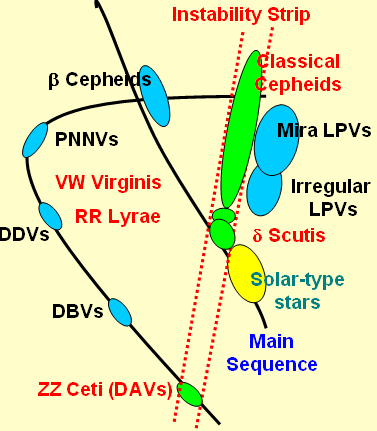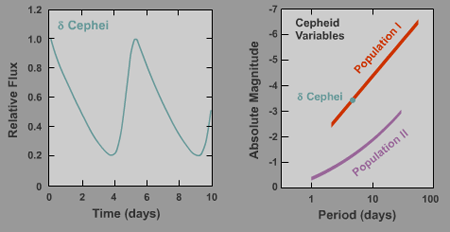When stars initiate core helium fusion, the star can
become unstable and pulsate. In fact, there are
several regions on an
H-R diagram that are
instability zones. If a stars evolution passes
through one of these zones, pulsations can occur:

(Image Credit - Swinburne Astronomy Online)
Variable stars are named after a prototype star
that exhibits a particular pulsation period.
What makes the star pulsate are the expanding and
contracting of a stars outer shell. As the star
increases in size, so does
luminosity - the opposite
for contraction. Increased heat from inside the star
causes the expansion - the expansion then causes
cooling. The cooled layers contract only to be
heated again.
One of the more famous variables stars is the
family of Cepheid variable stars. Discovered by
Henrietta Leavitt, these stars have a pronounced
Period-Luminosity relationship. Longer period
Cepheid were brighter than shorter period Cepheids. Because they are
luminous, they can be seen over great distanced.
Using the
distance modulus, it is possible to use the
Cepheid variable as a
ruler for interstellar
measurements.

(Image credit: Brooks/Cole Thomson Learning)
Cepheid rulers have been used for nearby
galaxies, but Type 1a supernova are better for
intergalactic distances.
RR Lyrae variable also make good rulers, and are
commonly found in
globular clusters. However, they
pulsate faster and have about a 1
magnitude
variation in
brightness.
Classes of Variable Stars:
| Variable Type: |
Population Type: |
Period of
Variability: |
| Long-Period Variables |
Population I and Population II |
100 - 700 days |
| Classical Cepheids |
Population I |
1 - 50 days |
| Type II Cepheids (W Virginis Stars) |
Population II |
2 - 45 days |
| RR Lyrae Stars |
Population II |
1.5 - 24 hours |
| delta Scuti Stars |
Population I |
1 - 3 hours |
| beta Cephei Stars |
Population I |
3 - 7 hours |
| ZZ Ceti Stars |
Population I |
100 - 1000 seconds |
Another class of Variable star is the cataclysmic
variable star. These are destructive events. There
are no know patterns to these types of variable
stars:
-
Classical Nova - recurrent explosions of a
star-white dwarf binary pair
-
recurrent nova - a white dwarf binary that
continues pulling material from a host star
- Supernova - the life's end of a large star
Only the recurring nova can be termed a "variable
star" although the variability is unpredictable.
More on this is available in
Stellar Evolution in
both the
low mass and
high mass sections.
Back
to Top |

